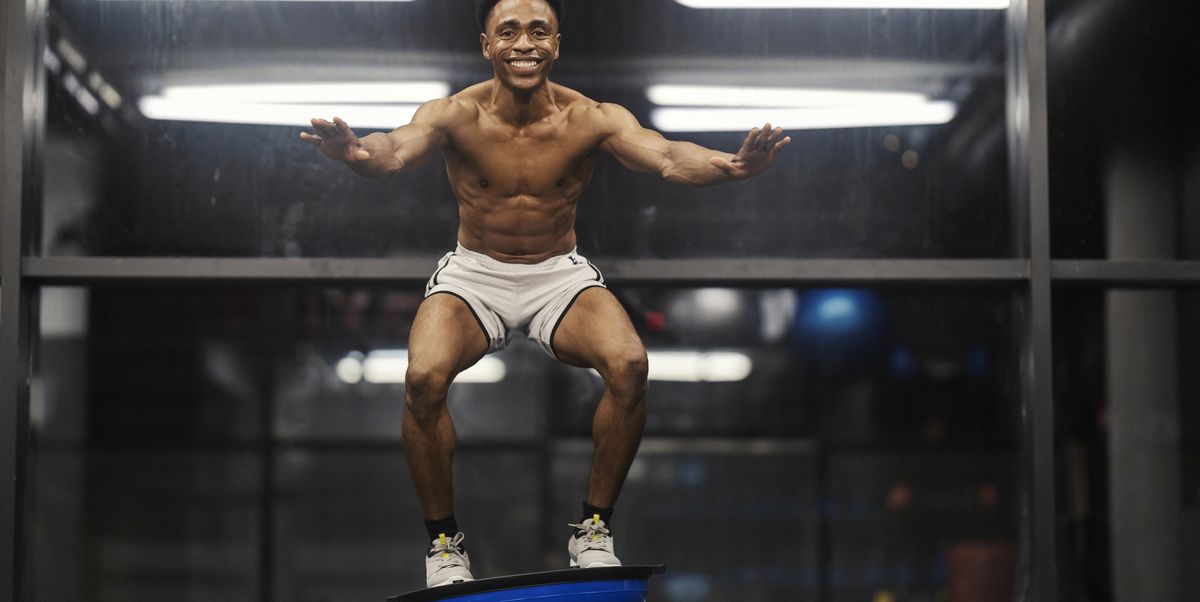According to sports scientist Dr Mike Israetel, we’re doing a bunch of exercises that ‘suck’. Well, not completely. But for a programme specifically dedicated to optimising hypertrophy as much as possible, we want to steer clear of some of these moves, to make the most of our precious gym time.
‘Look, all love and respect, all fun and games. Don’t take this shit personally,’ admits Israetel. ‘All of these exercises have their place. It’s just that in a programme designed to build as much muscle as possible and to lose as much fat as possible, and to build as much power and strength as possible, none of these exercises are really top tier. As a matter of fact, they’re bottom tier, barely in the conversation.’
‘We’re going to tell you why they suck,’ he adds, ‘and recommend much better replacements so you can get rid of the stupid bullshit.’
The Worst Exercises for Hypertrophy
Bosu Ball
‘The Bosu ball is number one worst offender,’ says Israetel. ‘Why? Well, it’s a great exercise modulation. You see, you can use the Bosu ball for anything. You can do squats on it. You can do lunges on it. You can do push-ups on it. And you know what’s even better? Doing all of those things off the Bosu ball.’
Israetel argues that the Bosu doesn’t deserve a place in our hypertrophy programme because when you’re on the ball, you become unstable. And because your body detects instability, it ramps down your ability to contract the biggest, most growth-prone parts of your muscles – and the ones that make you the strongest.
‘So, if you want to get on the ball to waste some time, hey, it’s awesome for that. If you want actual results in either strength or hypertrophy, whatever it is you’re doing on the ball, get off the ball and do it instead,’ recommends Israetel.
Kettlebell Swings
‘If you realise that the kettlebell swing is something you can just keep going with, but it’s very tough on the cardio situation, then kettlebell swings are a wonderful part to include in a circuit for overall general cardiovascular fitness,’ explains Israetel.
‘However, for resistance training, for growing the hamstrings or the glutes, or the lower back, or for sport training – developing strength and power and speed, all of those things – most of the forces [in a kettlebell swing] are horizontal, and in real sport most of the limiting forces are vertical.’
Instead, he recommends:
- Deficit deadlift
- Power clean
- Mid-thigh pull
‘They’re going to make you much bigger, much stronger and much faster,’ says Israetel.
Heavy Carries
Firstly, Israetel emphasises that heavy carries have their place in some functional training programmes. However, he argues, ‘Do heavy dumbbell and every other kind of implement carry actually build your traps? You bet. But what they also do is fatigue the living fuck out of you because heavy carries means very heavy. It’s a lot of pressure on the skeleton, which gives you awesome strong bones, but also saps the fatigue away that you could have dispersed over many other more productive exercises – not only to hit your traps but the rest of your body.’
Instead, for hypertrophy he says to include movements like presses, pulls, and deadlifts at a deficit: ‘All that stuff is going to give you hypertrophy and strength and metabolic adaptation.’
Bicycle Abs
‘Bicycle abs are all so dumb. Now, look, they’re not terrible. You have to cross your elbow across and touch your opposite knee and it does something to your abs, but it suffers from a few limitations,’ says Israetel.
The sports scientist argues that bicycle abs don’t stretch your abs, ‘And most importantly, how do you progress on it? If you can do bicycle abs for more than about a minute and 30 seconds, you’re already in really good shape. Any more time added is just going to make your abs have higher endurance – [it] won’t make them any more jacked.’
Instead he recommends:
- Decline weighted sit-up
- V-up
Turkish Get-ups
‘The Turkish get-up is better known as a parlour trick,’ says Israetel. ‘Biomechanists agree that it’s not exactly certain what the hell it is you’re either testing or training in the Turkish get-up. But most would say it’s probably the ability to keep your shoulder mobile enough to stay totally vertical, and the bare modicum of leg strength and total-body coordination it requires to stand up with a miniature kettlebell in your hand.’
Instead, Israetel recommends:
These challenge lower-body strength and overhead stability a lot more thoroughly than the Turkish get-up. Demonstrating the Turkish get-up, Israetel quips, ‘If I can do it, you know damn well it doesn’t make you athletic, because look at me.’






